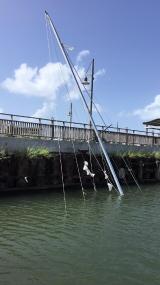News Releases from Headquarters
EPA Hurricane Maria Update for Tuesday, October 24th
10/24/2017
Contact Information:
EPA Press Office (press@epa.gov)
(WASHINGTON) — The U.S. Environmental Protection Agency (EPA) continues its round-the-clock response to Hurricanes Maria and Irma in close coordination with federal, commonwealth, territory, and local partners. EPA remains focused on environmental impacts and potential threats to human health as well as the safety of those in the affected areas.
EPA has completed preliminary assessments at EPA-led Superfund sites, oil sites, and chemical facilities in both Puerto Rico and the U.S. Virgin Islands to determine if the sites were affected by Hurricane Maria. The agency is now conducting any necessary follow up actions, such as fence and structure repairs. In addition, EPA is coordinating with the lead federal agencies for two other sites, Culebra and Vieques. EPA has made an initial visit to the Vieques Superfund site and was able to conduct a visual reconnaissance of portions of the former range. U.S. Navy personnel are scheduled to conduct additional assessment activities of the Navy-led site this week. The Culebra site is still inaccessible.
EPA is continuing to coordinate with government agencies in Puerto Rico and the USVI to assess the conditions of drinking water, w
hich includes sampling, analysis and lab support, and getting wastewater treatment systems up and running. EPA’s missions also include oil and chemical spill response, oil and chemical facility assessments and debris management.
Personnel
EPA continues to deploy personnel to Puerto Rico and the U.S. Virgin Islands as conditions allow. As of October 23, 2017:
• About 297 personnel are currently involved in hurricane response efforts.
• About 72 personnel are on the ground in USVI to assist with response efforts.
• About 125 personnel are on the ground in Puerto Rico to assist with response efforts.
Debris Management
Hazardous waste staging and collection areas are now up and running in Toa Baja and the southern municip
alities, and the agency continues to work with FEMA, the U.S. Army Corps of Engineers, and the Puerto Rico and USVI governments on debris management. EPA will assist with the handling and disposal of orphan containers, household hazardous waste, medical waste and e-waste. EPA plans to conduct air monitoring at collection areas and during all hazardous materials operations
Marine Operations
EPA is working with the US Coast Guard on marine operations to assess sunken vessels on th
e eastern coast of Puerto Rico and USVI.
Teams will locate and evaluate the condition of sunken vessels and assist with the disposal of recovered oil and hazardous materials. Approximately 249 vessels have been verified from field teams.
Assessment of Regulated Facilities
EPA teams have completed assessments at 240 fixed facilities in Puerto Rico and 65 in the USVI that are regulated under the Risk Management Plan (RMP), Facility Response Plan FRP), or Spill Prevention, Control, and Countermeasure (SPCC) programs.
Drinking Water and Wastewater Management
EPA continues to coordinate drinking water sampling with the U.S. Virgin Islands Department of Natural Resources. In Puerto Rico, EPA continues to work closely with the commonwealth government to assess both drinking water and wastewater systems.
Water Safety
According to the Centers for Disease Control and Prevention (CDC), people should not use the water from rivers, streams and coastal water to drink, bathe, wash, or to cook with unless first boiling this water for a minimum of one minute. If boiling the water is not possible, water may be disinfected with bleach. To learn more about making water safe in an emergency, go to CDC’s Making Water Safe in an Emergency web page.
For information and updates, visit: www.epa.gov/hurricane-maria.

